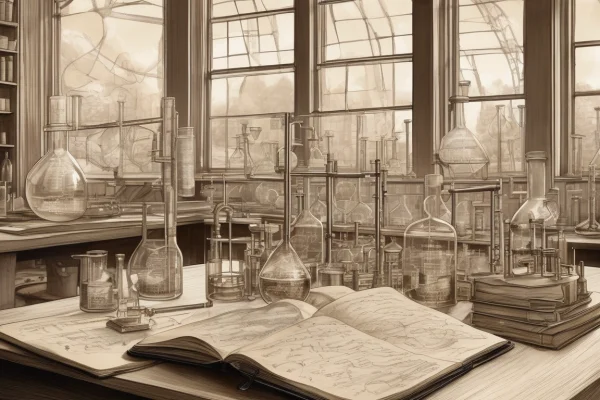Who Inspired the Discovery of DNA?

- Who Inspired the Discovery of DNA?
- Historical Background of DNA Discovery
- Key Figures in DNA Research
- James Watson and Francis Crick
- The Role of Rosalind Franklin
- Other Influential Scientists
- Technological Advances in DNA Research
- Impact of DNA Discovery on Science
- Advancements in Genetics
- Applications in Medicine and Forensics
- Legacy of DNA Discovery
- Frequently Asked Questions
The discovery of DNA is often hailed as one of the most significant milestones in the history of science. But have you ever wondered who inspired this groundbreaking achievement? The journey to uncover the secrets of genetic material was paved by numerous brilliant minds, each contributing their unique insights and discoveries. In this article, we will delve into the key figures and pivotal moments that inspired the discovery of DNA, exploring their profound impact on the field of genetics.
Before we dive into the individuals who played a crucial role in this monumental discovery, it’s essential to understand the historical context. The scientific environment of the early 20th century was ripe for breakthroughs in biology and genetics. With the advent of new technologies and methodologies, scientists were beginning to unravel the complexities of heredity. This period saw significant advancements in our understanding of cells, chromosomes, and the molecular basis of life.
Among the most influential figures in DNA research were James Watson and Francis Crick, whose collaboration led to the formulation of the double helix model. Their work was heavily inspired by the earlier findings of other scientists such as Erwin Chargaff, who discovered the base-pairing rules, and Rosalind Franklin, whose X-ray diffraction images provided critical insights into DNA’s structure. It’s fascinating to see how these scientists’ contributions intertwined, much like the strands of DNA they studied.
| Scientist | Contribution |
|---|---|
| James Watson | Co-discoverer of the double helix structure of DNA. |
| Francis Crick | Co-discoverer of the double helix structure of DNA. |
| Rosalind Franklin | Provided critical X-ray diffraction images of DNA. |
| Erwin Chargaff | Discovered base-pairing rules that guided Watson and Crick. |
In summary, the discovery of DNA was not the result of a single individual’s genius but rather a collective effort inspired by the work of many. The interplay of ideas and discoveries from various scientists laid the groundwork for one of the most important scientific revelations of our time. As we reflect on this incredible journey, it becomes clear that the legacy of these pioneers continues to inspire new generations of researchers in the field of genetics.
Historical Background of DNA Discovery
The journey to uncover the secrets of DNA is a fascinating tale that stretches back over a century. Before the double helix structure was famously identified, several pivotal moments and discoveries laid the groundwork for this monumental achievement. Understanding the historical context of DNA discovery is essential, as it highlights the scientific environment that fostered innovation and creativity.
In the early 20th century, genetics was still in its infancy. The groundwork was laid by Gregor Mendel, whose experiments with pea plants in the 1860s revealed the fundamental laws of inheritance. However, it wasn’t until the 1900s that scientists began to understand the molecular basis of genetics. The discovery of chromosomes and the role they play in heredity opened new avenues for exploration.
As we delve deeper into the timeline, we can identify several key milestones:
| Year | Milestone | Key Contributors |
|---|---|---|
| 1869 | Isolation of Nuclein | Friedrich Miescher |
| 1944 | DNA as Genetic Material | Avery, MacLeod, McCarty |
| 1953 | Double Helix Structure | Watson, Crick, Franklin |
These milestones reflect the collaborative nature of scientific discovery. Each finding built upon the last, leading to a greater understanding of DNA’s role in heredity. The work of early scientists, such as Friedrich Miescher, who first isolated nuclein (now known as DNA), was crucial. His discovery set the stage for future research, although it would take decades for the significance of DNA to be fully recognized.
In this ever-evolving landscape, we also see the influence of technology and methodology. The advent of X-ray diffraction techniques, championed by Rosalind Franklin, provided insights into DNA’s structure that were previously unimaginable. It’s almost like piecing together a complex puzzle, where each scientist contributed a vital piece to complete the picture.
As we reflect on the historical background of DNA discovery, it becomes clear that this was not just the achievement of one individual, but rather a collective effort that spanned generations. The collaboration among scientists and their relentless pursuit of knowledge paved the way for groundbreaking discoveries that continue to influence modern science.

Key Figures in DNA Research
The journey to uncovering the secrets of DNA was not a solo expedition; it was a collaborative effort involving many brilliant minds. Each key figure brought unique insights and groundbreaking methodologies that paved the way for the discovery we celebrate today. Among these influential scientists, James Watson, Francis Crick, and Rosalind Franklin stand out as the most prominent contributors, each playing a vital role in the understanding of DNA’s structure and function.
To appreciate their contributions, let’s take a closer look at their individual journeys and how they intersected in this monumental scientific achievement:
| Scientist | Contribution | Year |
|---|---|---|
| James Watson | Co-discoverer of the double helix structure of DNA | 1953 |
| Francis Crick | Co-discoverer of the double helix structure of DNA | 1953 |
| Rosalind Franklin | Produced X-ray diffraction images crucial for DNA structure | 1952 |
| Erwin Chargaff | Discovered base pairing rules (A-T and C-G) | 1940s |
| Linus Pauling | Proposed a triple helix model, influencing later research | 1953 |
Watson and Crick’s collaboration was like a thrilling race, fueled by the excitement of discovery and the pressure of competition. They famously used Franklin’s X-ray diffraction images, which revealed the helical structure of DNA, as a critical piece of the puzzle. However, it’s essential to recognize that Franklin’s contributions were often overshadowed in a male-dominated field, highlighting the challenges faced by women in science during that era.
Additionally, figures like Erwin Chargaff laid the groundwork for understanding DNA through his discovery of base pairing rules, while Linus Pauling made early attempts to model the structure of DNA. Their collective efforts not only inspired Watson and Crick but also set the stage for future research in genetics.
In conclusion, the discovery of DNA was not merely the result of a single genius but rather a tapestry woven from the threads of many brilliant minds. Each scientist brought their own spark of inspiration, illuminating the path that led to one of the most significant breakthroughs in biological science.
James Watson and Francis Crick
When we think about the discovery of DNA, the names James Watson and Francis Crick often come to mind first. These two brilliant scientists are credited with unraveling the structure of DNA, a breakthrough that has reshaped our understanding of genetics. But how did they achieve this monumental feat? Let’s dive into their story!
In the early 1950s, the scientific community was buzzing with excitement over genetics, but the structure of DNA remained a mystery. Watson and Crick, both young and ambitious, were determined to crack this code. They combined their knowledge of chemistry and biology, fueled by the work of other scientists, to create a model that would change everything.
| Key Contributions | Details |
|---|---|
| Double Helix Model | Proposed the twisted ladder structure of DNA, which explained how genetic information is stored and replicated. |
| Collaboration | Worked closely with Rosalind Franklin’s X-ray diffraction images to confirm their model. |
| Publication | Published their findings in the journal Nature in 1953, which laid the foundation for modern genetics. |
Their collaboration was not just about sharing ideas; it was a true partnership. Watson’s enthusiasm and Crick’s analytical mind complemented each other perfectly. They were like two sides of the same coin, working tirelessly to piece together the puzzle of life itself. Imagine trying to solve a jigsaw puzzle without knowing what the final picture looks like—this is exactly what they faced!
Despite their groundbreaking work, it’s important to recognize the contributions of others, particularly Rosalind Franklin. Her meticulous X-ray diffraction images provided the critical clues that led Watson and Crick to their discovery. Unfortunately, her role was often overshadowed in a male-dominated scientific era, which is a reminder of the challenges women faced in science.
In conclusion, the partnership between Watson and Crick was a perfect storm of intellect, determination, and collaboration. Their discovery of the DNA structure not only unlocked the secrets of genetics but also paved the way for future research that continues to impact our lives today. Isn’t it fascinating how one discovery can ripple through time, influencing countless fields, from medicine to forensic science?
The Role of Rosalind Franklin
Rosalind Franklin was a pivotal figure in the discovery of DNA, often overshadowed by her male counterparts, yet her contributions were nothing short of revolutionary. Born in 1920, Franklin was a brilliant scientist whose expertise in X-ray crystallography provided some of the first clear images of DNA’s structure. Her famous Photo 51 was instrumental in revealing the helical shape of DNA, a breakthrough that would ultimately lead to the understanding of genetic material.
Despite her groundbreaking work, Franklin faced numerous challenges, particularly in a scientific community dominated by men. Her meticulous research methods and attention to detail were vital in shaping our understanding of DNA. In fact, it was her X-ray diffraction images that prompted Watson and Crick to develop their double helix model. However, Franklin’s contributions were often overlooked, highlighting the gender biases prevalent in science during her time.
| Key Contributions of Rosalind Franklin | Impact on DNA Research |
|---|---|
| X-ray Crystallography | Provided critical images that revealed DNA’s helical structure. |
| Photo 51 | Enabled Watson and Crick to formulate their model of DNA. |
| Research on Viruses | Contributed to understanding the structure of viruses, furthering molecular biology. |
In her own words, Franklin once stated, The science of today is the technology of tomorrow.
This quote reflects her belief in the transformative power of scientific discovery. Her work not only paved the way for future DNA research but also inspired countless women in science to pursue their passions despite societal obstacles.
In summary, Rosalind Franklin’s role in the discovery of DNA cannot be overstated. Her legacy serves as a reminder of the importance of recognizing all contributors to scientific advancement, regardless of gender. As we continue to explore the complexities of genetics, it is essential to honor the groundbreaking work of pioneers like Franklin who laid the foundation for modern molecular biology.
Other Influential Scientists
While James Watson, Francis Crick, and Rosalind Franklin are often the stars of the DNA discovery story, there are several other influential scientists who played critical roles in shaping our understanding of genetics. Their groundbreaking research laid the foundation for the monumental discoveries that followed. Without their contributions, the narrative of DNA might look quite different!
One of the key figures in this journey was Erwin Chargaff. His work in the 1950s led to the formulation of Chargaff’s rules, which state that in any given DNA molecule, the amount of adenine (A) equals thymine (T), and the amount of guanine (G) equals cytosine (C). This crucial insight provided the first clues about the base pairing that would later be integral to the double helix model.
Another significant contributor was Linus Pauling, a renowned chemist who proposed a triple helix structure for DNA. Although his model was ultimately incorrect, Pauling’s innovative thinking pushed other scientists to explore different possibilities, paving the way for Watson and Crick’s eventual discovery. His ability to think outside the box exemplifies how scientific progress often comes from a mix of correct and incorrect hypotheses.
| Scientist | Contribution |
|---|---|
| Erwin Chargaff | Formulated Chargaff’s rules on base pairing |
| Linus Pauling | Proposed a triple helix structure |
| Hershey and Chase | Demonstrated that DNA is the genetic material |
Additionally, the work of Avery, MacLeod, and McCarty in the early 1940s was pivotal. They showed that DNA, not proteins, was the substance responsible for heredity, challenging the prevailing belief at the time. Their experiments with bacterial transformation were revolutionary, demonstrating that DNA carries genetic information.
In summary, while the spotlight often shines on Watson, Crick, and Franklin, it is essential to recognize the contributions of these other influential scientists. Their collective efforts created a rich tapestry of knowledge that ultimately led to the groundbreaking discovery of DNA. As we delve deeper into the world of genetics, we must remember that great discoveries are rarely the result of a single mind but rather the culmination of many brilliant ideas and collaborations.
Technological Advances in DNA Research
When we think about the discovery of DNA, it’s easy to overlook the remarkable technological advancements that made this groundbreaking achievement possible. Imagine trying to solve a complex puzzle without the right tools—frustrating, right? That’s essentially what early scientists faced before the advent of modern technology. The journey to uncover the intricacies of DNA was paved by a series of innovations that transformed the scientific landscape.
One of the most pivotal breakthroughs was the development of X-ray crystallography, which allowed scientists like Rosalind Franklin to visualize the structure of DNA. Her famous Photo 51 provided crucial insights into the double helix structure, a moment that can be likened to finding the missing piece of a jigsaw puzzle. Without such images, the path to understanding DNA would have been significantly longer.
In addition to X-ray techniques, the invention of the polymerase chain reaction (PCR) in the 1980s revolutionized DNA research. This technique enables scientists to amplify small segments of DNA, making it much easier to study and manipulate genetic material. Think of it as a magnifying glass that allows researchers to zoom in on the details of DNA, transforming the way we approach genetics.
| Technological Innovation | Impact on DNA Research |
|---|---|
| X-ray Crystallography | Visualized DNA structure, leading to the double helix model. |
| Polymerase Chain Reaction (PCR) | Enabled amplification of DNA, facilitating easier analysis. |
| Next-Generation Sequencing (NGS) | Allowed rapid sequencing of entire genomes, revolutionizing genomics. |
Furthermore, the rise of next-generation sequencing (NGS) has dramatically changed the landscape of DNA research. This technology allows for the rapid sequencing of entire genomes, making it possible to analyze vast amounts of genetic data in a fraction of the time it once took. The implications of NGS extend far beyond mere research; it has opened doors in fields like personalized medicine and genetic testing, allowing for tailored treatments based on an individual’s unique genetic makeup.
In conclusion, the technological advances in DNA research have not only propelled our understanding of genetics but have also inspired a new era of scientific exploration. Just as a skilled artist relies on their brushes and colors, scientists depend on these technologies to paint a clearer picture of life at the molecular level. With each innovation, we move closer to unlocking the mysteries of our genetic code.
Impact of DNA Discovery on Science
The discovery of DNA has had a profound impact on numerous scientific fields, reshaping our understanding of life itself. Imagine a world where the very blueprint of organisms was a mystery; that was the reality before DNA was unraveled. Today, DNA is not just a scientific term; it’s a cornerstone of modern biology, genetics, and medicine. This revolutionary breakthrough has paved the way for advancements that were once thought to be the stuff of science fiction.
One of the most significant areas affected by the discovery of DNA is genetics. With the understanding of DNA’s structure and function, scientists have been able to:
- Develop genetic engineering techniques that allow for the modification of organisms.
- Advance gene therapy, which holds the promise of treating genetic disorders at their source.
- Implement personalized medicine, tailoring treatments based on an individual’s genetic makeup.
Furthermore, the implications of DNA research extend into fields like medicine and forensics. The ability to analyze DNA has transformed how we approach disease diagnosis and treatment, making it possible to identify genetic predispositions and create targeted therapies. In forensics, DNA profiling has revolutionized criminal investigations, allowing law enforcement to accurately identify suspects and exonerate the innocent.
| Field | Impact of DNA Discovery |
|---|---|
| Genetics | Enabled genetic engineering and personalized medicine. |
| Medicine | Improved disease diagnosis and treatment options. |
| Forensics | Enhanced accuracy in criminal investigations through DNA profiling. |
In essence, the discovery of DNA has not just influenced science; it has redefined it. As we continue to explore the complexities of genetic material, the legacy of this monumental achievement will undoubtedly inspire future research, leading to innovations that could change the course of humanity. As Rosalind Franklin once said, “Science and everyday life cannot and should not be separated.” The impact of DNA discovery is a perfect embodiment of this sentiment, intertwining our scientific pursuits with the very fabric of life.
Advancements in Genetics
The discovery of DNA has not only reshaped our understanding of life but also propelled the field of genetics into a new era of innovation and exploration. With the double helix model as a foundation, scientists have been able to delve deeper into the molecular mechanisms of heredity. This has led to groundbreaking advancements that have transformed various aspects of biology and medicine.
One of the most significant advancements in genetics is the development of gene editing technologies. Techniques like CRISPR-Cas9 have revolutionized the way we manipulate genetic material. Imagine having a pair of molecular scissors that can cut and paste DNA sequences with precision! This technology allows scientists to not only correct genetic defects but also to enhance certain traits in organisms.
| Technology | Year Introduced | Impact |
|---|---|---|
| CRISPR-Cas9 | 2012 | Revolutionized gene editing |
| Gene Therapy | 1990 | Treats genetic disorders |
| Next-Generation Sequencing | 2005 | Accelerated genome mapping |
Additionally, advancements in genetic sequencing have made it possible to decode entire genomes in a fraction of the time it once took. The advent of next-generation sequencing has opened the floodgates for research, allowing scientists to explore genetic variations across different populations and species. This has profound implications for understanding diseases, evolution, and biodiversity.
Moreover, the field of personalized medicine has emerged as a direct consequence of our enhanced understanding of genetics. By analyzing an individual’s genetic makeup, healthcare providers can tailor treatments that are more effective and have fewer side effects. This approach marks a significant shift from the traditional “one-size-fits-all” model of medicine.
In summary, the advancements in genetics since the discovery of DNA have been nothing short of revolutionary. From gene editing to personalized medicine, the impact of these developments continues to inspire researchers and healthcare professionals alike. Who would have thought that a molecule as simple as DNA could lead to such profound changes in our understanding of life and health?
Applications in Medicine and Forensics
The discovery of DNA has opened up a world of possibilities in both medicine and forensics. Imagine a tool that can unlock the secrets of life and solve crimes—this is what DNA has become. In medicine, DNA analysis is at the forefront of diagnostics and treatment, allowing for personalized approaches to healthcare. For instance, genetic testing can identify predispositions to certain diseases, enabling proactive measures that can save lives.
In the realm of forensics, DNA has revolutionized how criminal investigations are conducted. It provides a reliable method to link suspects to crime scenes through biological evidence such as blood, hair, or saliva. The accuracy of DNA profiling has made it a cornerstone of modern forensic science, often serving as the definitive proof in court cases.
| Application | Description | Impact |
|---|---|---|
| Genetic Testing | Identifies genetic disorders and predispositions. | Enables early intervention and personalized medicine. |
| Gene Therapy | Treats diseases by correcting defective genes. | Offers potential cures for previously untreatable conditions. |
| Forensic Analysis | Links suspects to crime scenes through DNA evidence. | Increases conviction rates and exonerates the innocent. |
Moreover, the applications of DNA in forensics don’t just stop at solving crimes. They extend to identifying victims in disasters and even in paternity tests. The implications of DNA technology are vast and continue to evolve. For example, advancements in DNA sequencing have made it possible to analyze entire genomes quickly and affordably, further enhancing our understanding of genetic conditions and improving therapeutic strategies.
In summary, the applications of DNA in medicine and forensics are transformative. They highlight the power of this remarkable molecule, not just in understanding life but also in bringing justice and healing to society. As we continue to explore the depths of DNA research, who knows what other groundbreaking discoveries await us?

Legacy of DNA Discovery
The discovery of DNA is not just a milestone in science; it is a monumental achievement that has transformed our understanding of life itself. The legacy of this discovery continues to resonate across various fields, inspiring ongoing research and innovation. Think of DNA as the blueprint of life, and its discovery as unlocking a treasure chest of knowledge that has profound implications for humanity.
One of the most significant impacts of the DNA discovery is in the realm of genetics. The understanding of DNA has paved the way for groundbreaking advancements in genetic engineering, gene therapy, and personalized medicine. For instance, scientists can now manipulate genes to treat genetic disorders, which was once thought to be pure science fiction. This has opened doors to possibilities we could only dream of a few decades ago.
| Field | Impact of DNA Discovery |
|---|---|
| Genetics | Revolutionized genetic engineering and therapy. |
| Medicine | Enabled personalized medicine and targeted treatments. |
| Forensics | Transformed criminal investigations through DNA analysis. |
Moreover, the implications of DNA research stretch beyond just science. It has influenced ethical debates and societal discussions regarding cloning, genetic modification, and the nature of life itself. As we delve deeper into the genetic code, we are faced with questions that challenge our moral compass. How far should we go in altering life? What are the consequences of playing God?
To encapsulate the essence of the legacy left by DNA discovery, consider the following:
- Inspiration for future scientists and researchers.
- Foundation for biotechnological advancements.
- Continued exploration of the mysteries of life.
In conclusion, the legacy of DNA discovery is a rich tapestry woven from scientific breakthroughs, ethical dilemmas, and a quest for understanding. It has not only shaped modern science but has also ignited a passion for exploration, ensuring that the story of DNA continues to inspire generations to come.
Frequently Asked Questions
- Who were the key figures in the discovery of DNA?
The discovery of DNA was shaped by several brilliant minds, including James Watson, Francis Crick, and Rosalind Franklin. Each of these scientists made significant contributions that helped unveil the structure and function of DNA, leading to groundbreaking advancements in genetics.
- What role did Rosalind Franklin play in DNA research?
Rosalind Franklin was instrumental in the discovery of DNA’s double helix structure through her pioneering work in X-ray diffraction. Her famous Photo 51 provided critical evidence that guided Watson and Crick in their model, yet she faced considerable challenges in gaining recognition in a male-dominated field.
- How has the discovery of DNA impacted modern science?
The discovery of DNA has transformed various scientific fields, particularly genetics and medicine. It has paved the way for innovations such as gene therapy, genetic engineering, and personalized medicine, revolutionizing how we diagnose and treat diseases.
- What technological advances contributed to DNA research?
Technological innovations, such as polymerase chain reaction (PCR) and DNA sequencing techniques, have played a crucial role in DNA research. These tools have allowed scientists to analyze genetic material with unprecedented precision, unlocking the mysteries of heredity and disease.
- What is the legacy of the DNA discovery?
The legacy of DNA discovery is profound, influencing not only the field of genetics but also shaping our understanding of life itself. It has inspired countless research endeavors and continues to impact areas like biotechnology, forensics, and evolutionary biology.





